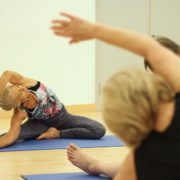Stretches not Working? Three Reasons Why
Do you suffer from chronic muscle tightness or back stiffness and ever wonder… why aren’t my stretches working?
Perhaps you’ve Googled and YouTubed every stretch under the sun but still – you haven’t gained an ounce of mobility.
There are a few reasons why all your stretching efforts might not be doing anything for you. It could be your technique. It could be that you’re doing the wrong stretch. Or, it could be that you just shouldn’t be stretching at all!
Let’s go over the different reasons why your stretching routine could be failing you – and most importantly – what you can do about it.
You’re doing it wrong.
Although research studies are inconclusive regarding how long you should hold a particular stretch, most people feel good when they hold a stretch for 30-60 seconds. When it comes to technique, one of the biggest problems I see is not relaxing enough. If you’re tense, or gripping your muscles at the same time you’re stretching, it won’t work very well. It’s important to breathe and move easily into any stretch you’re doing. If you try to force it or push through pain, you’ll likely tense up.
Now let’s say you’re doing everything right (not tensing or gripping) but your stretches still don’t seem to work. Some people (myself included) respond better to “moving stretches.” This is where instead of holding one static position for a prolonged period, you repeatedly move through one or several end-range stretches. Moving neck rolls are a great example of this. If you’ve been diligently stretching and not seeing the results you want, try adjusting your technique. Moving stretches might be a better strategy than static holding. I know for me it is!
You’re doing the wrong type of stretch.
This one could be a little tougher to figure out on your own. There is a difference between corrective stretching and stretching to feel good. For example, let’s say your back is tightening up because you’ve been under a lot of stress or you just did a lot of activity that stiffens up your back. Generic back stretches, such as bringing your knees to your chest or child’s pose, may be all you need to quickly get rid of the general stiffness you’re experiencing.
But let’s say you have associated back pain, or pain and numbness running down your leg. In these instances, generic back stretches won’t work or could even make you worse. You likely need corrective stretches, like what we prescribe for patients in our office. Corrective stretches are specifically prescribed to address symptoms, and are very different from the generalized stretches that are designed to feel good and relieve tension.
You shouldn’t be stretching at all.
Did you know that chronic muscle tightness can be a sign of a weakness? This is a very common problem with our clients. I’ve seen many folks over the years with chronic tightness and discomfort in their neck, backs, hips, etc. – and no matter how often they stretch or massage, it doesn’t improve.
How does this happen?
Well, groups of muscles are connected by this substance called fascia. If one group of muscles in the “fascial line” are not doing their job, a different group of muscles will have to take up the slack. When muscles are tasked with more work than they are intended for, they can become tight.
For example, if your deep core is not working properly, then the front of your neck will often kick in and try to help. If your neck is always sore or tight after a good ab workout, this is what could be happening. Stretching your neck won’t help one bit in this case – because what you need to be doing instead is strengthening your core. I see this same pattern with tight hips flexors. Once people start strengthening their core properly – the chronic tightness magically melts away.
Remember, when we are attacking the correct problem and doing the right thing – our body will respond. If you’ve been stretching and stretching and not seeing results – something is missing.
The longer your problem goes on, the more time it has to develop into a complicated fix.
If you’re suffering from any kind of pain or tightness that is keeping you from doing the things you love, our specialists are here to help!
Just CLICK HERE to request a Free Discovery Session!



